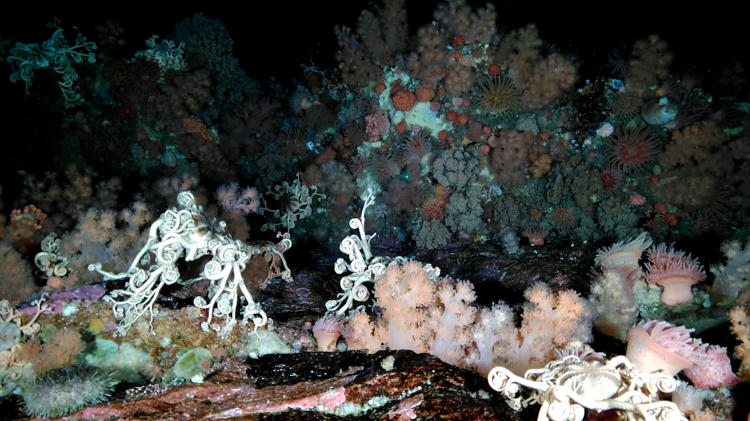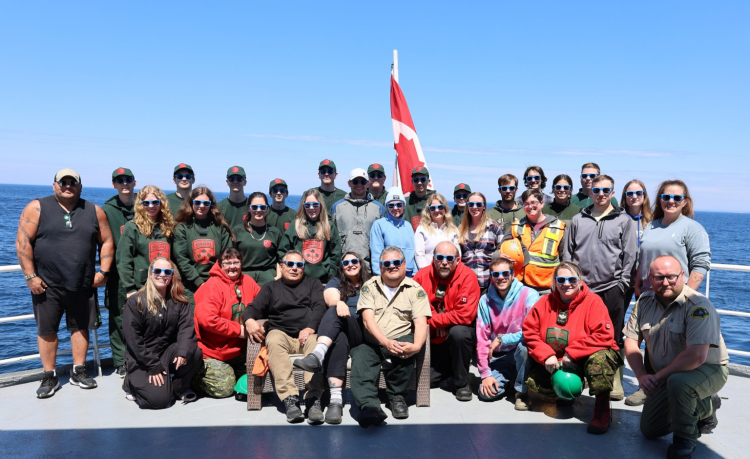Marine Institute researchers taking part in the Marine Conservation Area project discovered a densely populated soft coral garden northeast of Fogo Island, N.L., during a science and student training expedition in late June.
Researchers say it is rare to find such densities of cold-water soft coral species, especially at water depths of less than 200 metres.
You can see the coral garden in the video below.
Located in a complex rocky habitat, early estimates suggest the coral garden spans about 10,000 square metres of the sea floor within the Funk Island Deep marine refuge off Newfoundland and Labrador.
The diverse marine life includes anemones, sponges, basket stars and many soft corals.
Cold-water soft corals inhabit sea floor ecosystems, including the Northwest Atlantic and Arctic oceans.
Unlike tropical warm-water corals, they do not need sunlight to live.
'Astonishing habitat'
PhD candidate Emmeline Broad captured the colourful, soft coral garden on video using an innovative observation system known as a BathyCam that she designed and deployed.
It integrates a specialized SubC Imaging camera rated for water depths up to 6,000 metres.
"Many people played a significant role leading up to this discovery," said Ms. Broad, who is working on her doctorate in environmental science. "The richness and abundance of marine life within this habitat is astonishing, and I have never seen anything quite like it at such shallow water depths."
She is also a member of the 4D Oceans Lab.
Led by Dr. Katleen Robert in the School of Ocean Technology, the lab creates high-resolution maps of the sea floor and uses underwater cameras to explore marine habitats and map their distribution.
They teamed up with the Marine Conservation Areas (MCA) project led by Dr. Jonathan Fisher of the Centre for Fisheries Ecosystems Research (CFER) in collaboration with Fisheries and Oceans Canada.
The five-year project monitors species and gathers habitat information in marine refuges off Newfoundland and Labrador.
It also provides hands-on training to students in minimally invasive, data-collection techniques.
Spotted a year ago
The coral garden discovery stems from an interesting sea floor feature spotted a year ago by CFER fisheries technologists Martin Dahl and Robyn Whelan, who were working on the MCA project.
"We saw a very sharp mound on the sea floor," said Mr. Dahl. "It was the most interesting topography that we had seen in the area. Underwater hills and slopes often feature unique habitats."
They were collecting acoustic data of the sea floor as their research vessel MV Patrick and William travelled to a scheduled sampling site.
"It creates the image as we're going over the sea floor," said Ms. Whelan. "We knew at some point we wanted to come back and put a camera down there."
An opportunity for a closer look came in June during a series of voyages on board the MV Polar Prince in collaboration with the vessel's owner, the Miawpukek First Nation, and band council member Gregory Jeddore.
Conducting research and providing Indigenous youth with scientific learning experiences were among the goals of the Polar Prince expeditions.
Future MCA project expeditions will aim to establish the coral garden's size, the species living there and its ecological importance in supporting marine biodiversity in the northwest Atlantic.
'Corals as far as the eye can see'
Dr. Bárbara Neves, research scientist with Fisheries and Oceans Canada in St. John's, says the soft coral garden is an extraordinary find.
"It's corals as far as the eye can see," she said. "Soft corals of the species seen in the videos are knowingly abundant in the northwest Atlantic, but witnessing them at these densities in their natural habitat is rare.
"We have seen live soft corals in relatively high densities near Nain and Frobisher Bay and even near St. John's," she added, "but the observations recorded by the Marine Institute team also appear to be extraordinary due to their large extent."

In the foreground, a marine plant known as pink encrusting algae covers the rocky seabed. Also in the foreground are basket stars, an invertebrate with slender, twisting arms. Sea sponges, anemones and soft coral cover the rest of the seabed. Photo: Submitted
The June expedition also included a team of Marine Institute student interns, graduate students and research staff from CFER and the Centre for Applied Ocean Technology; scientists from Fisheries and Oceans Canada in St. John's; and members of the Miawpukek First Nation and Junior Canadian Rangers.

Members of the June expedition to the Funk Island Deep marine refuge. Photo: Submitted










